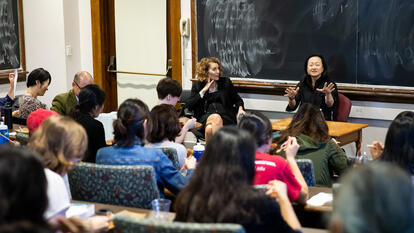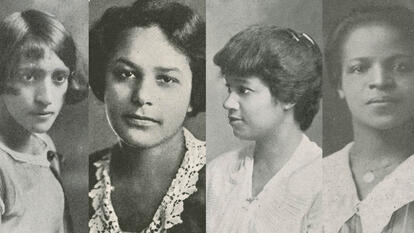Wellesley Launches New Online AP Italian Language and Culture Course

Vuoi parlare italiano? For the 3,101 students who have enrolled in Wellesley’s new online AP Italian Language and Culture course, the answer is Sì, sì! The free, interactive course, which launched August 7, is designed to help high school students prepare for the AP Italian exam and gain language proficiency. Yet as enrollment statistics demonstrate, the students—who come from around the world—range in age from 16 to 89; the highest percentage of students are age 22.
Course instructor Daniela Bartalesi-Graf , a lecturer in Wellesley’s Department of Italian Studies, said those numbers reflect the need for Italian instruction, which is not available in most U.S. high schools except in regions with a high concentration of Italian immigrant or heritage populations. “This is a problem shared by other middle-tier languages, including Portuguese and Arabic,” said Bartalesi-Graf, who spent the past year developing the course. “If students come to college without any prior instruction in Italian, it’s very difficult to bring them to a point of fluency within four years. But if they study the language for a few years in high school, they begin at the intermediate level.”
The AP Italian class lets students work at their own pace through six units, each of which features videos and interviews with notable Italian speakers; newspaper articles and radio programs about life in Italy; and readings from major Italian writers from the 20th and 21st centuries, including Umberto Eco, Italo Calvino, Susanna Agnelli, and Laila Wadia. The material also includes grammar reviews with downloadable PDF charts and self-corrected activities, audio files that allow students to practice their speaking skills, and a forum where students can discuss the course material and ask Bartalesi-Graf questions.
Students who want more guidance and instruction can also register for one of Wellesley’s online live instruction classes, which will be offered in the evenings and/or Saturdays, beginning September 25. These classes will feature 19 online meetings over the next eight months; five online, individual conversations with an Italian university student (a native speaker); and help from an instructor, who will correct and grade six student papers and 13 audio files. All of the assignments have been designed to prepare students for the AP Italian exam in May, said Bartalesi-Graf, but will be useful to any adult learner wishing to practice and improve his/her proficiency in Italian. Students will also receive a certificate from Wellesley College with a letter grade upon completion of the course, which they can present to their high school for inclusion on their school transcript and/or to their employer as recognition of achievement and language proficiency.
“Online courses respond to a growing demand by students that study material be delivered to them in a variety of innovative ways that allows them to study at a time and in a place that suits them,” said David Ward, professor of Italian studies and chair of the department.
When designing the course, Bartalesi-Graf drew on the experience she gained while developing and teaching Wellesley’s earlier Italian edX courses: Beginner, Intermediate, and Advanced, which were the first Italian courses to be offered as MOOCs (Massive Open Online Courses) by any college or university. More than 85,000 students signed up for those free courses; they were archived early in 2017, after running for a year.
“Daniela has assessed student learning and continually refined and improved the material and methods in these courses,” said David O’Steen, senior instructional technologist and director of Wellesley’s Blended Learning Initiative. “She has created new content expressly designed for the AP Italian course, and included innovative elements such as quizzes embedded in videos so one can get immediate feedback as one is learning new material, and audio files to practice answering questions exactly like it is done on the AP Italian exam.”
Collaboration among Wellesley faculty and staff has also been key to the success of these courses, said Bartalesi-Graf, who credits O’Steen; Ravi Ravishanker, CIO and associate provost; Jarlath Waldron, instructional media director; Jason Estey, videographer; Laura O’Brien, research and instructional librarian; and Jillian Rubman, instructional designer, with helping her turn her vision into digital reality. (Elena Gnudi and Valentina Giovannini, Italian language assistants from the University of Bologna, also contributed to many aspects of the project, as did volunteers Cynthia Coddington and Lynn Hennessey, residents of Wellesley who audited the earlier Italian courses.)
Bartalesi-Graf also received three grants from the Ministry of Foreign Affairs in Italy, which enabled her to create videos for the course of renowned Italian speakers, including chef Lidia Bastianich, who was filmed at one of her restaurants in New York; soccer player Andrea Pirlo; Italian journalist Federico Rampini, who discussed the Italian Constitution; and Eugenia Paulicelli, who talked about Italian fashion. The Italian Consulate in Boston provided the help of Carmen Petrucci, who assisted in developing the audio files included in both versions of the AP course.
Bartalesi-Graf said such broad support indicates the importance of helping students understand the Italian language and culture. “Italy has shaped Western thought in many areas, including art, literature, political science, and science,” she said. “Knowing Italian culture means knowing a lot about the origins of Western civilization, which is important for any humanist now.”



